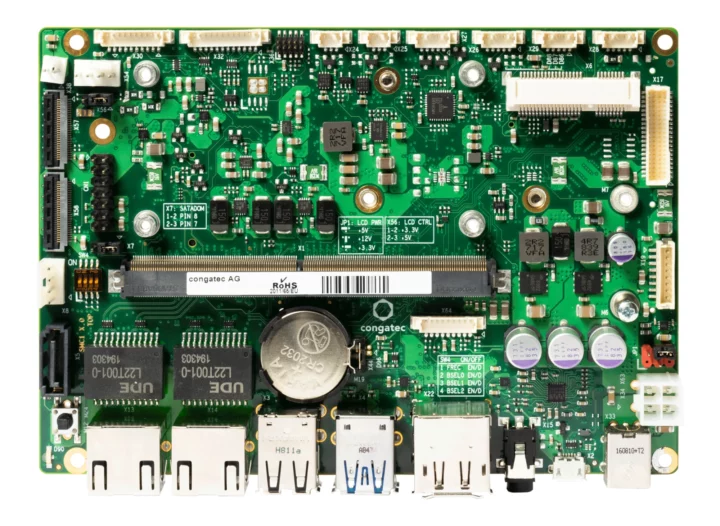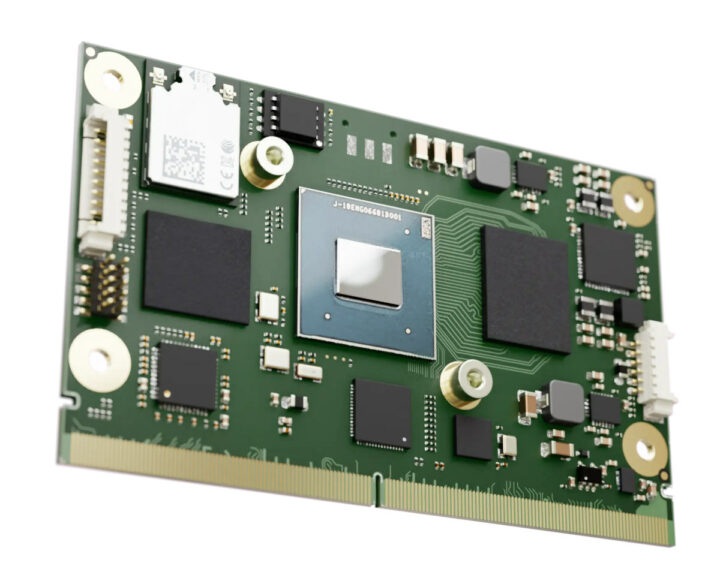We had already written about NXP i.MX 95 SMARC 2.1 system-on-modules from ADLINK, iWave Systems, Avnet, and Advantech, but congatec has now launched its own with the conga-SMX95 featuring the NXP i.MX 9596 hexa-core Arm Cortex-A55 AI processor and up to 16GB LPDDR5 memory.
The conga-SMX95 also comes with up to 256GB flash, is available on both commercial and industrial temperature grade variants, and exposes most of the same interfaces as competing products. What might be different is that the conga-SMX95 is offered with an optional M.2 1216 WiFi 6 and Bluetooth 5.3 wireless module. We’ve seen M.2 1216 wireless modules before, and they don’t use any M.2 socket but are LGA packages that need to be soldered to the target board/module.
conga-SMX95 specifications:
- SoC – NXP i.MX 9596
- CPU
- Up to 6x Arm Cortex-A55 application cores clocked at 1.8 GHz (industrial) or 2.0 GHz (commercial) with 32K I-cache and D-cache, 64KB L2 cache, and 512KB L3 cache
- 1x Arm Cortex-M7 real-time core clocked at 800 MHz
- 1x Arm Cortex-M33 safety core clocked at 333 MHz
- GPU – Arm Mali-G310 V2 GPU for 2D/3D acceleration with support for OpenGL ES 3.2, Vulkan 1.2, OpenCL 3.0
- VPU
- 4Kp30 H.265 and H.264 encode and decode
- JPEG Encoder, JPEG Decoder
- AI Accelerator – NXP eIQ Neutron 2 TOPS neural processing unit (NPU) with 750 inf/sec
- CPU
- System Memory – Up to 16GB LPDDR5 up to 6400 MT/s; inline ECC
- Storage – Up to 256GB eMMC flash
- Networking
- 2x GbE controllers with TSN support
- Optional M.2 1216 WiFi 6 and Bluetooth 5.3 (on module)
- 314-pin MXM edge connector
- Storage – SDIO 3.0
- Display interfaces
- Dual channel 24-bit LVDS
- DisplayPort 1.4 1080p60 through 4-lane MIPI DSI to DisplayPort bridge (shared with MIPI DSI)
- Optional 4-lane MIPI DSI
- Optional HDMI 2.0a through 4-lane MIPI DSI to HDMI bridge (shared with MIPI DSI)
- Camera – Up to 2x 4-lane MIPI CSI
- Audio – 2x I2S
- Networking – 2x Gigabit Ethernet with Time Sensitive Networking (TSN)
- USB
- 1x dual-role USB 2.0
- 2x USB 2.0
- 2x USB 3.0
- PCIe – 2x PCIe Gen3 x1
- Other peripheral interfaces
- Up to 3x UART interfaces (2x with handshake)
- 2x CAN FD
- 1x I2C, 1x SPI, 1x QSPI
- 14x GPIO with interrupt, one GPIO with PWM
- Security
- NXP EdgeLock 2GO key management services
- Cryptographic Acceleration and Assurance Module
- Resource Domain Controller
- Arm TrustZone
- High Assurance Boot support
Encryption Engine – AES-128, AES-256, 3DES, RC4, RSA4096, TRNG, SHA-1, SHA-2, SHA-256, MD-5 - RSA-1024, 2048, 3072, 4096, and secure key storage
- Side-channel attack resistance
- Debugging
- Cortex-M7 and Cortex-M33 console
- Optional JTAG debug interface
- Misc
- High Precision Real Time Clock
- Watchdog Timer
- PMIC – 3x PMIC (likely PF0900, PF5301, PF5302)
- Power consumption – 3 to 8W
- Dimensions – 82 x 50 mm (SGET SMARC Specifications 2.1 form factor)
- Temperature Range
- Operating – Commercial: 0°C to 60°C; industrial: -40°C to 85°C
- Storage – Commercial: -20°C to 80°C; industrial: -40°C to 85°C
- Humidity
- Operating – 10-85% RH, non-condensing
- Storage – 5-85% RH
Congatec provides support for Linux via the Yocto Project and Android for the SMARC 2.1 module and the bootloader is U-boot. It’s also the first time I’ve come across “NXP i.MX 9596” instead of just “NXP i.MX 95”, and although it’s not listed on the NXP website, it does not look like a typo since several companies also use the same part number. The “6” in the name looks related to the number of cores, so i.MX 9596 is the hexa-core version, i.MX 9594 the quad-core version, and i.MX 9592 the dual-core variant.
Two carrier boards are supported namely the “conga-SEVAL” evaluation carrier board for SMARC modules and the “conga-SMC1/SMARC-ARM” 3.5-inch carrier board for congatec SMARC modules based on NXP i.MX SoCs.

I could not find pricing information for the conga-SMX95 i.MX 9596 model. but the conga-SMC959-4C-4G-eMMC32 is sold on Mouser for $238 in single units with the NXP i.MX 9594 quad-core processor. Additional details may be found on the product page.

Jean-Luc started CNX Software in 2010 as a part-time endeavor, before quitting his job as a software engineering manager, and starting to write daily news, and reviews full time later in 2011.
Support CNX Software! Donate via cryptocurrencies, become a Patron on Patreon, or purchase goods on Amazon or Aliexpress







Hello, how are you doing? I wish best of things always!!!!
I’ve been reading most of your articles been post on your blog that relates to hardware.
I just want to ask few questions if you know about designing hardware and also, what do you know about phone/sms hardware hacking hardware that can accelerate to read programmable hardware as well as searching for software?
Best regards